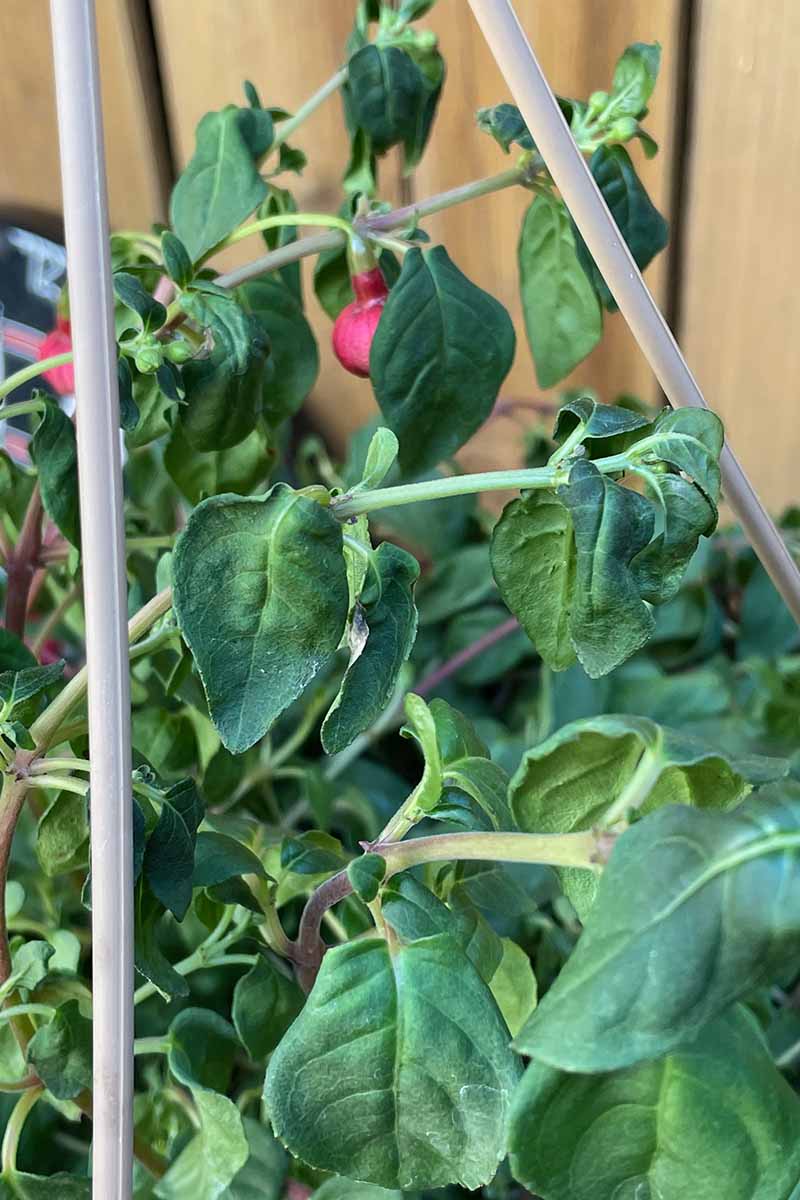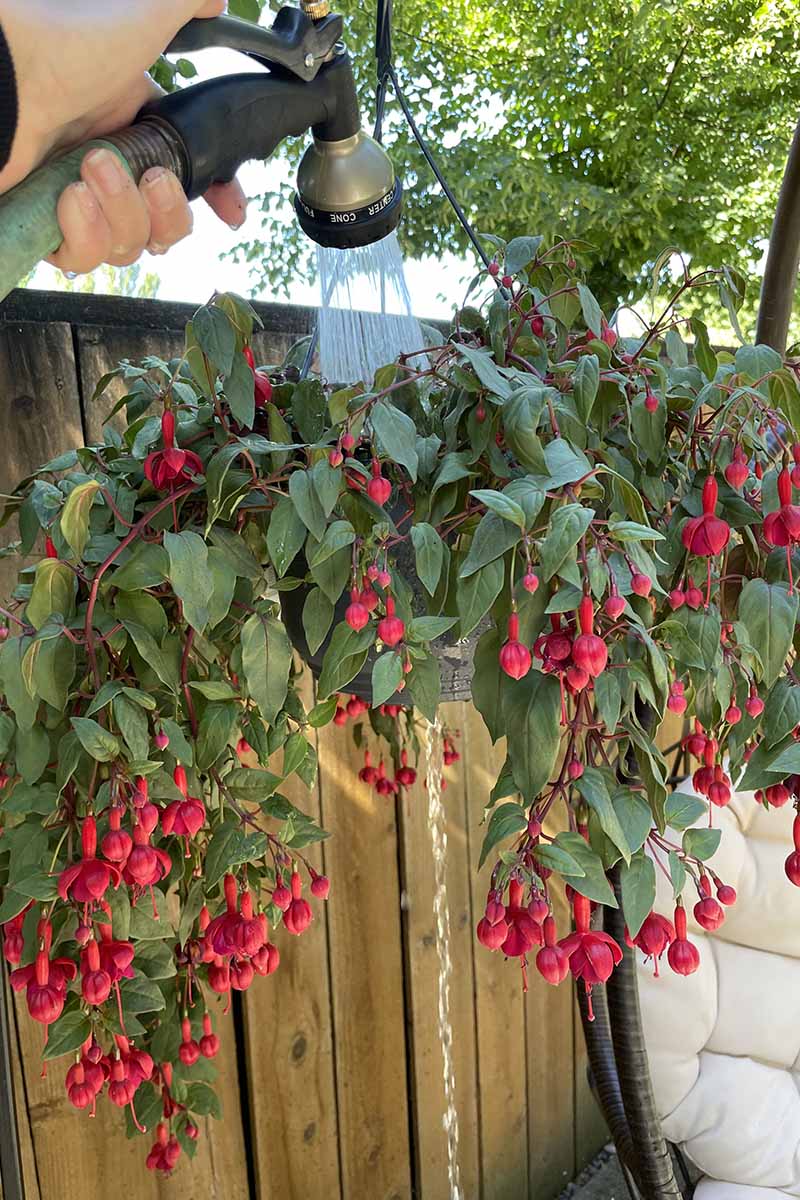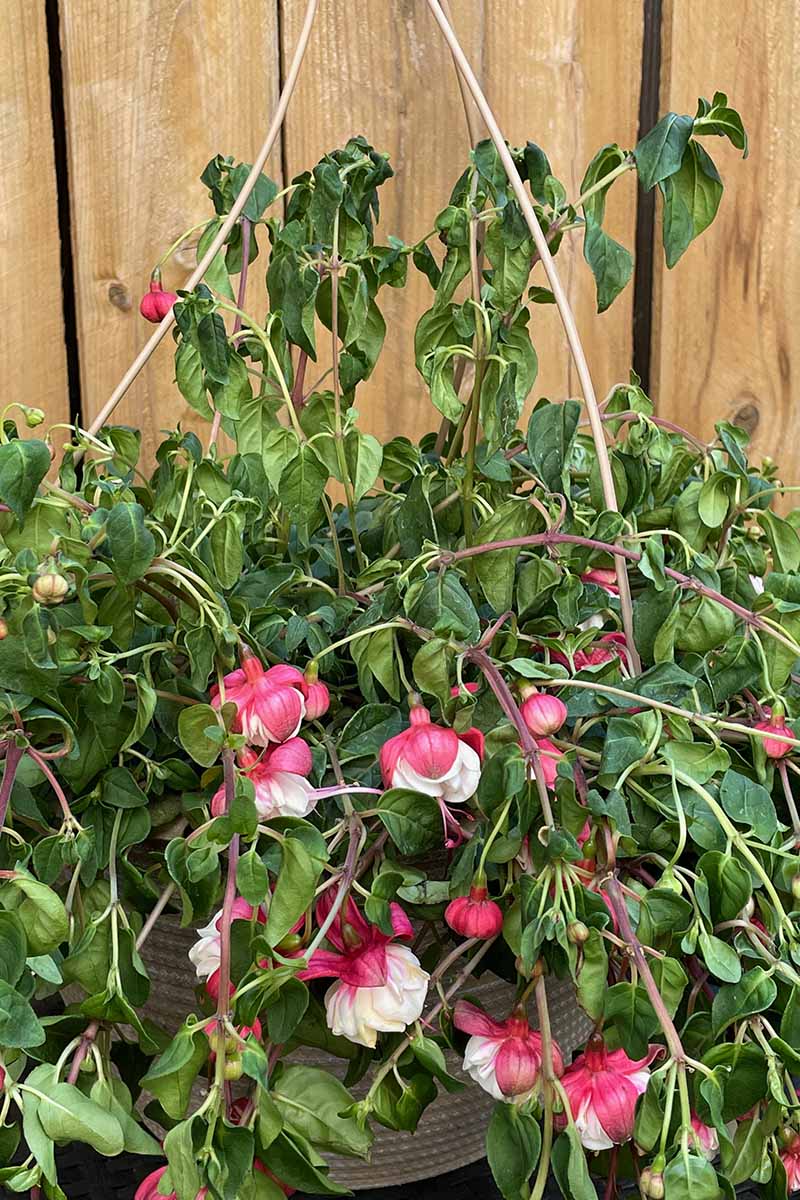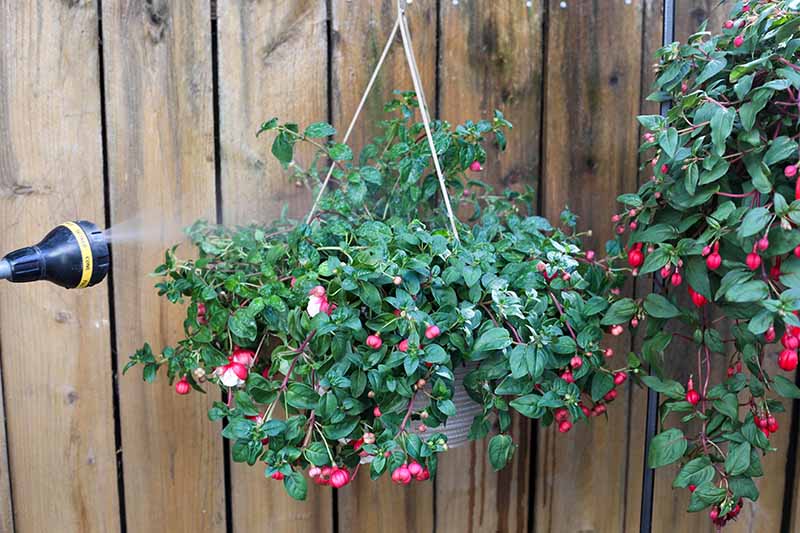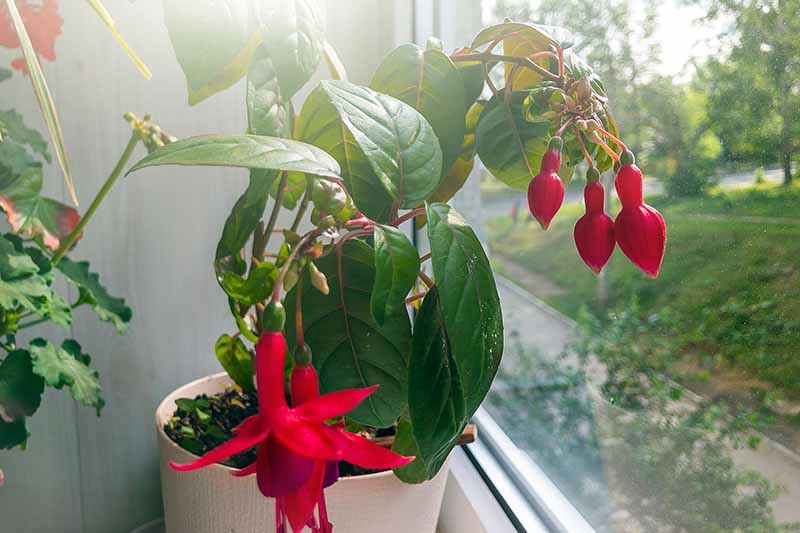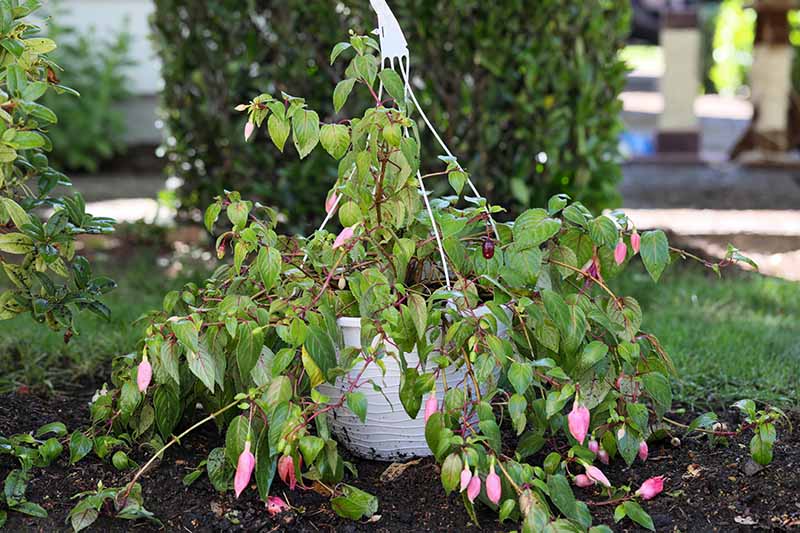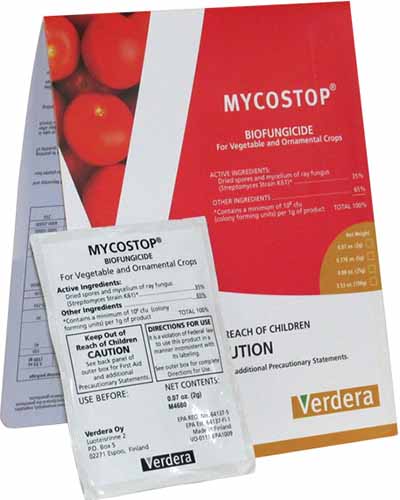These plants are fussy about the temperature and the amount of water they like. Plus, there are a number of pests and diseases that may attack them. Any one of these can cause your fuchsia to droop. We link to vendors to help you find relevant products. If you buy from one of our links, we may earn a commission. With that in mind, here is what we’ll cover in the coming guide:
Why Do Fuchsias Wilt?
Just so we’re all on the same page, what do we mean by wilting? It’s when the leaves and soft stems don’t have enough water and become droopy. The plant loses its rigidity, the leaves may look darker, and the foliage may curl. Wilting is a plant’s defense mechanism, or it is the result of not having enough water moving throughout its system, for whatever reason. A fuchsia wilts because it doesn’t have the moisture it needs to hold its cells open, and keep the leaves and stems erect. When a plant wilts in defense, it is reducing the amount of leaf surface exposed to wind and sunlight so that it can retain more of its moisture until better conditions come around. There are three main reasons a fuchsia will wilt:
Too much waterNot enough waterHeat
We’ll cover these in the following sections, with additional troubleshooting tips. They may also wilt if they’re attacked by pests or diseases. This is less common, so we’ll conclude with those possible issues.
5 Common Culprits
Chances are your fuchsia can be saved with no lasting damage if you act quickly, so let’s not wait any longer to get the situation sorted!
1. Not Enough Water
Let’s begin with the most common issue, shall we? All types of flora need water, but fuchsias like lots of it. If they are too dry for too long, they will wilt. How can you tell if this is the problem? If you touch the soil and it feels dry, your plant needs some moisture. It’s usually that simple! In a perfect world, fuchsia would always have consistently moist – but not wet – soil that drains well so the roots aren’t overly saturated. But in the real world, conditions aren’t always so perfect. We forget to water, or maybe we have an unexpected dry spell. An underwatered fuchsia will let you know it needs more moisture by wilting. If this happens over and over, you might see leaves turn yellow, or the tips of the leaves become dry and brown. Your plant might also drop its flowers. This is the quickest and easiest cause of wilting to remedy, which is good since it is so common. Simply add water until the soil is saturated and water runs out of the drainage holes for potted plants. For fuchsia that’s growing in the ground, the earth should feel like a moist sponge. Your precious plant should start perking right back up within a few hours. In addition, those incredibly popular hanging pots are particularly susceptible to drying out. They’re dangling up there in the air with their little pots exposed to the wind and light without much insulation. On top of that, fuchsias are usually packed in there pretty tightly, so there isn’t a lot of soil surrounding the roots. You need to be extra diligent to keep these watered. If the roots are too dry for too long, they’ll be damaged and the plant won’t recover, or it will only recover partially. If your dry fuchsia doesn’t perk back up after 24 hours, try pruning back the branches by half and wait to see if there are enough remaining healthy roots to supply the now-smaller plant with water. For hanging pots, you might need to add moisture more than once a day during warm spells. If you can’t commit to that much watering or you prefer to err on the side of caution, consider moving them to the ground in a shady spot during the hottest days of the year. For more tips on watering, head over to our guide on watering fuchsias.
2. Too Much Water
So we know fuchsias love water, but is there such a thing as too much? Yup! These plants don’t like standing water. Before you assume a wilting plant is dying of thirst, touch the soil. Does it feel wet? Don’t add more moisture! Too much water isn’t just an issue of giving a fuchsia more than it needs. Sometimes it’s about soil that is too compacted or that doesn’t have enough drainage. Roots need oxygen. If the earth is too compact or it drains poorly, even a small amount of water can sit around the roots and suffocate them. If your plant is wilting and the earth feels soggy, first things first, stop watering. Let the soil dry out for a day or two, and see if the foliage perks back up. If it does, reduce your watering and make sure you’re checking the soil before adding more. But if it doesn’t revive, or if the soil doesn’t dry out, you might need to improve the soil situation. Remove the whole plant, roots and all, from the ground or container, and wash the dirt away to expose the roots. Cut away any black, soggy, transparent, or dead roots. Then, replant it in fresh soil, and make sure it’s well draining!
3. High Temperatures
Fuchsias don’t want to be hot – and who can blame them? If it gets too toasty, the foliage will droop, even if the soil is perfectly moist. Rice Hulls Rice hulls are an environmentally-friendly option that’s more affordable than perlite or vermiculite. You can pick up quarter, half, or full cubic-foot bags at Arbico Organics. If you’re replanting in the ground, work in plenty of well-rotted compost, or consider planting in a raised bed instead. If this happens, don’t add moisture to the ground or container! You risk stressing the plant further by waterlogging the roots. When the temps climb into the mid 80s and above, especially if the air is dry and humidity is low, your fuchsia may suffer and start wilting. If it’s a hot day, check the soil before watering to see if the heat may be the cause. I left this one, pictured below, in the back of my car on a hot day. Oops! If the soil is moist, don’t add water. Instead, if you have a hanging plant, move it to a shady, cool spot on the ground. Potted fuchsias can be moved to a shadier spot as well. Mist the foliage with water, and leave the plant in its shady spot to cool down until better weather returns. It should perk up once it cools a bit. This is that same plant a few hours after being misted and moved to the shade. For fuchsias growing indoors, check to be sure that they aren’t being roasted by the sun through a window. If they are in direct sun in the heat of the day or during a period of particularly hot weather, move them and mist the foliage. Keep in mind that heat stress can happen whether the soil is wet or dry. If you touch the soil and it feels dry, add water. But if your plant doesn’t perk up, mist the leaves and move it to a cooler spot, if possible.
4. Pests
Assuming you have the watering situation sorted and the weather isn’t too hot, you might need to take a closer look at your plants to see if the wilting problem is being caused by pests. This is less common, and you’ll usually see other signs of an issue beyond just wilting and drooping if pests are to be blamed. Aphids are prevalent pests. They suck the sap out of the leaves and stems. Whiteflies also suck the sap out of plants, causing wilting and yellowing leaves. Our guide to growing fuchsias has more information on identifying and eliminating these pests.
5. Diseases
If the problem isn’t pest or water related, it’s likely that your beloved floral friend has contracted a disease. The most common of these are fungal in nature. Botrytis blight, rot, rust, and verticillium wilt are all fungal diseases that can cause wilting. This one in the photo below is struggling with a nasty case of rust, causing it to look wilted and sad. Avoid these problems in the first place by taking care to water in the morning, water at the soil level, and don’t let the foliage become overly crowded. Otherwise, a biofungicide like Mycostop is effective against a broad range of fungal issues. Mycostop You can purchase Mycostop, which uses mycelium and the spores from Streptomyces Strain K61 to battle a variety of pathogens, at Arbico Organics in five-gram or 25-gram packets.
Perk Your Fuchsia Back Up
It’s disheartening to discover that your beautiful fuchsia has taken a turn for the worse. But now that you know how to fix it, it doesn’t have to bring you (or your plant) down! Figure out the cause and get going on the solution, and your lovely fuchsia will be perky again before you know it. What kind of fuchsia are you growing? Have you addressed any of the issues described here? Tell us in the comments – and include pictures if you like. We love to see all the pretty plants out there. Then, for more information on growing fuchsias, I’m sure you’ll enjoy these guides next:
Do Fuchsias Need Deadheading?How to Prepare Your Fuchsia Plants for WinterTips for Growing Fuchsia as HouseplantsHow to Harvest and Save Fuchsia Seeds

